Bicycle covers: varieties, pros and cons, recommendations for choosing
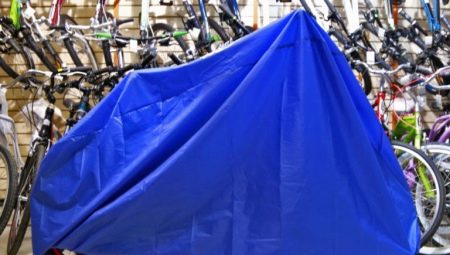
Owners of bicycles and e-bicycles, especially those who like long trips and travels, need to get a case-box or a bike carrier. You should know what it is, what these accessories are, and how to use them.
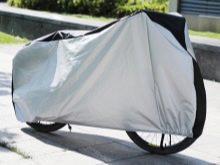


Why do we need bicycles?
Protective bike covers are needed for many reasons. First of all, they are necessary for lovers of travel and travel to other cities and countries. In accordance with the rules for the carriage of goods, transportation of bicycles on trains and airplanes is allowed only disassembled and compactly packed. In addition, as practice shows, bicycle bags are used not only in active cycling, but also in everyday life:
- bike bag makes it more convenient to move and store, reducing the number of protruding elements (pedals, front wheel and steering wheel turned to the frame);
- the packed bike does not stain others, does not scratch or tear the car's interior trim;
- covers are often used as mats for a halt during camping trips;
- individual models in expanded form, if necessary, play the role of an awning.

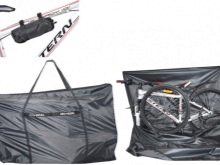
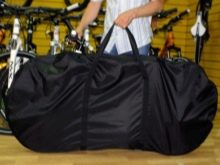
A bike bag must meet the following requirements:
- be made of durable, but at the same time lightweight fabric;
- freely accommodate the bike with the wheels;
- fasten securely and quickly.
If possible, supplement the cover with handles so that it can be conveniently hung over your shoulder.


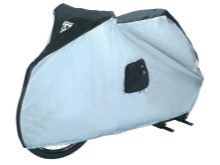
Textile
Many bike owners prefer to sew their own bike covers. To do this, use sugar bags or regular shopping bags.As a rule, they buy the largest model that is only presented in the store and reshape along the contours of the bike. These cases have serious drawbacks: their appearance is not aesthetically pleasing enough, and the material of such products usually does not differ in particular strength and water resistance. Loose canvases, which are used for the manufacture of bags, are quickly torn by levers on the steering wheel of a bike, pedals and speed switches.
It is best to give preference to ready-made waterproof bicycles, which can be purchased at any sports store... In this case, you can spend the night in the forest or on the river bank even in the rain. The waterproof product can be used as a cape for your bike, and if necessary, you can hide under the cover yourself, simply by pulling it between the trees. However, you will have to pay extra for comfort: waterproof models are much more expensive.

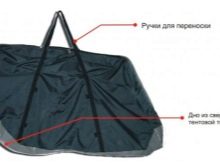
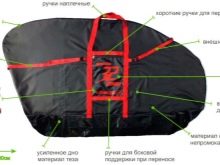
Experienced users recommend covers made from modern dense fabrics, for example, from Rip Stop Sport. This fabric is used in the manufacture of branded sportswear and all the necessary equipment. The advantages of the fabric are obvious:
- in the event of a tear, the material does not tear further due to the use of a special technology of weaving of threads;
- the canvas is lightweight;
- the fabric does not get wet even in heavy rain;
- Made of Rip Stop Sport fabric, soft and hard bike covers weigh no more than 300 g.

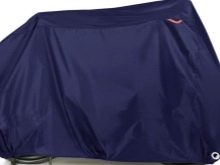
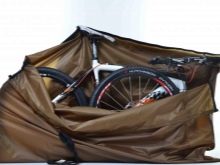
Views
There are 3 types of covers, which differ significantly from each other.
- Soft bicycle accessories. They are sewn from linen in 1 layer. Such models are the most used: most often, cyclists purchase covers for storing bikes and for the purpose of comfortable transportation. Soft items are the most affordable budget models.
- Solid. These bicycles are made of a special coarse canvas, which is used in 2 or more layers. In most cases, these fabrics are treated with impregnations that increase the water resistance of the material. Hard models can be used as a bag for transporting bikes and are much better quality than soft products. The dense fabric reliably protects the bike from any external damage and impact. Typically, such models have an average cost, the price directly depends on the number of layers of canvas.
Manufacturers position the material used for sewing soft and hard bicycles as waterproof. In practice, this statement is true only for the first time the product is used: in the process of active use, the cover rather quickly turns into a "sieve". This is especially noticeable when it is often transported in the luggage compartment of an aircraft.
- Hard covers are called bike boxes. The products are made of plastic and visually resemble suitcases for moving double basses. Most often, hard cases are used for sports, mountain and professional touring bikes, as well as for e-bikes. They are the only reliable protection when transporting an "iron friend" in an airplane. The coatings prevent rust on metal parts, so they can be used for storing bicycles in the winter. The hard case is ideal for an e-bike.
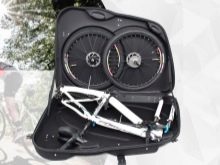


However, the boxes are not without some disadvantages:
- while riding a bike, you will not be able to carry a wardrobe trunk on it;
- the product has a large weight and dimensions, so the transportation of such luggage in a car is difficult;
- buying such a bicycle cover will cost you a pretty penny: their cost is quite high.
Having disadvantages, hard bicycles are not widely used. Their use only makes sense when transporting bikes of a high level and value. Depending on the design, the covers can be made in several versions.
- Cover-sock - mini-version of "clothes" for the bike. The bike carrier is put on from wheel to wheel and can stretch 160-200 cm.
- Bicycle case - models with a rigid frame, hide the entire product.
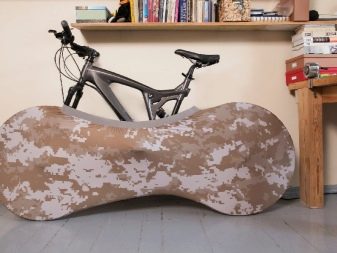
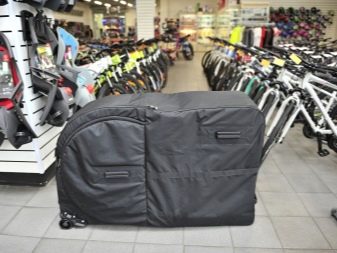
Features of choice
At first glance, it may seem that choosing a bike bag is not difficult. This is not the case; when buying the necessary accessory, you should pay attention to several fundamental points.
- If possible, give preference to bicycles with wheels. This will allow you to easily move the bike along the road from the car to the destination, through the airport, train station. Agree, this is much easier than carrying a lot of weight on your own shoulder.
- When choosing a bike case, preference should be given to models with handles. On the way, you will encounter steps, bumps in the road or other obstacles, in which case you will have to lift the bike - then the straps or handles will come in handy. They will allow you to carry the bike over your shoulder and relieve your hands.
- Lockable covers are preferred by some bike owners... On the one hand, such products increase the safety of transportation. On the other hand, consider how often you plan to leave your bike unattended. Moreover, if you are going to fly by plane, and customs officers, for example, consider it necessary to check the contents of the bag, they will still open it, even if it is locked. Therefore, decide for yourself whether you should pay extra for this dubious security.
- Go for roomy models, even if you have the smallest or foldable bike right now. It is possible that after a short time you will change it to a larger road or sports model, which will require more impressive storage.


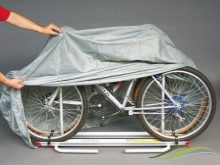
Before purchasing, determine the minimum dimensions for the case. To do this, you need to take into account 2 parameters:
- the length of the bike from the lowest point of the rear wheel to the top of the seat;
- the distance from the extreme point of the rear wheel to the extreme point of the rudder.
It should be borne in mind that all measurements must be made with the front wheel removed.


Packing the bike
To fit your bike in a soft or hard bag, it should be turned up with the wheels. You need to start putting on the cover from the rear wheel: in this position, during all manipulations, the steering wheel will act as a support for the bike and will not allow it to roll over. Overall, the packaging principle is simple: first the volumetric details, after them - the smaller ones.

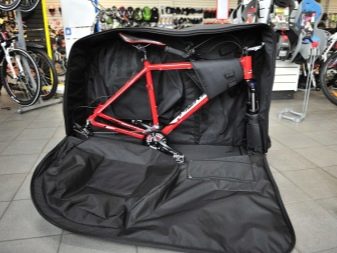
When transporting over long distances, it is best to use rigid cases. To do this, you need to remove not only both wheels, but also the pedals, handlebars, and the seatpost. This will require a certain investment of time, however, due to special fasteners and foam padding of the box, your "iron friend" will reach your destination in complete safety.
For an overview of the bike cover, see the video below.








